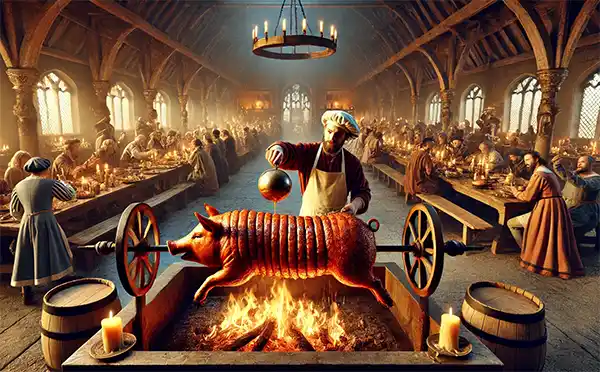A Celebration of Culinary Tradition and Crispy Perfection
There’s something about a perfectly roasted suckling pig that feels both luxurious and timeless. National Roast Suckling Pig Day, celebrated annually on December 18th, is a delicious homage to this golden, crispy, and succulent centerpiece of countless feasts. Whether it’s a holiday table groaning under its weight or a historical banquet fit for royalty, the suckling pig has been tantalizing taste buds for centuries. Let’s dive into the fascinating history, culinary artistry, and modern-day festivities that make this day an absolute feast—with just a touch of humor to keep things light.
What Exactly is a Suckling Pig?
If you’re unfamiliar with the term, a suckling pig is a young piglet—usually around 2 to 6 weeks old—that has been fed solely on its mother’s milk. This unique diet makes the meat tender, delicate, and slightly sweet, while the roasting process produces a perfectly crispy skin that shatters like glass when done right.
Now, while the idea of roasting an entire piglet might seem extravagant to some, it’s been a symbol of celebration and abundance for millennia. Across cultures and centuries, serving a whole roasted suckling pig has been an act of culinary artistry and a testament to one’s cooking prowess (and patience—because roasting a piglet to perfection is not for the faint of heart).
 Fit for Kings and Commoners
Fit for Kings and Commoners
The history of the suckling pig is as rich and savory as the dish itself. The practice of roasting these young pigs dates back thousands of years and spans continents.
- Ancient China: The Chinese perfected the art of roasting suckling pigs, with records dating back to the Han Dynasty (202 BC). The crackling skin and tender meat became a centerpiece of important celebrations, particularly Lunar New Year feasts.
- Medieval Europe: Suckling pigs were considered a delicacy during feasts for nobility. Think lavish banquets where kings and queens devoured roasted piglets alongside goblets of wine while jesters entertained in the background. (They didn’t have Netflix yet.)
- Spanish Lechón: Spain takes suckling pig to a whole new level with their iconic dish, lechón asado. Regions like Castile are famous for their perfectly roasted pigs, often cooked in wood-fired ovens to achieve that coveted crispiness.
- The Americas: European settlers brought the tradition of roasting suckling pigs to the New World, where it became a festive staple, especially in the southern United States and Caribbean.
From medieval banquets to backyard barbecues, the suckling pig has remained a symbol of festivity, unity, and the universal love of crispy, roasted goodness.
A Culinary Balancing Act
Roasting a suckling pig is equal parts science, art, and a test of patience. Here’s the basic process (don’t try this while hangry):
- Preparation: The piglet must be cleaned, seasoned, and marinated. Traditional marinades might include olive oil, garlic, salt, pepper, and aromatic herbs like rosemary and thyme. Some chefs go bold with citrus, wine, or even whole apples stuffed into the pig’s mouth for that classic banquet look.
- The Roast: Achieving the golden, crackling skin while keeping the meat tender requires slow roasting at a low temperature. Traditionally, a suckling pig is spit-roasted over an open flame or cooked in a wood-fired oven. For home chefs, an oven will do, but you’ll still need hours of slow, steady cooking.
- The Finale: The final step—and arguably the most satisfying—is that glorious, crispy skin. Some chefs brush the pig with oil or honey in the final moments to achieve a caramelized, golden finish that shatters with every bite.
Pro tip: If you hear crackle, you’re doing it right.
How to Celebrate National Roast Suckling Pig Day
Sure, not everyone has the time (or oven space) to roast a whole pig, but that doesn’t mean you can’t celebrate in style. Here are a few ways to enjoy this crispy, succulent day:
- Go to a Restaurant: Many restaurants serve suckling pig as a special dish during the holidays. Treat yourself to a dining experience that doesn’t involve hours of basting and sweating.
- Host a Feast: If you’re feeling ambitious, gather your friends and family for an epic roast. Pro tip: start early, because no one likes a hangry crowd staring at a half-cooked pig.
- Make a Small-Scale Version: Can’t commit to the full pig? Roast a pork shoulder or ribs instead. It’s like a mini tribute without the intimidating logistics.
- Learn the History: Dive deeper into the cultural traditions surrounding suckling pig. Watch videos of Spanish chefs roasting lechón or explore how different cultures prepare this dish.
- Get Creative with Leftovers: If you’re lucky enough to have leftovers, turn that tender pork into tacos, sandwiches, or soups. It’s the feast that keeps on giving.
Fun Suckling Pig Facts
There’s more to this crispy, crackling masterpiece than meets the eye. Beyond its succulent meat and legendary skin, the suckling pig has left its mark on culinary traditions around the globe. From ancient feasts to modern celebrations, these fascinating facts prove that roasting a piglet is no ordinary culinary affair.
- The oldest recipe for roasted pig comes from ancient Roman texts. Their version often involved honey, wine, and herbs.
- In Spain, lechón asado is so revered that it’s often cut with a plate instead of a knife to demonstrate how tender the meat is.
- The skin of a perfectly roasted suckling pig is called crackling. It’s so prized that people will fight over the crispiest pieces—even at family dinners.
- In Chinese culture, the suckling pig is a traditional dish served at weddings and celebrations as a symbol of good fortune and prosperity.
- Roasting a pig on a spit was once a public spectacle, with people gathering to watch the process during festivals and special occasions.
National Roast Suckling Pig Day is more than just a foodie holiday—it’s a celebration of history, culture, and the pure joy of sharing a special meal with loved ones. Whether you’re feasting on a perfectly roasted piglet or simply enjoying a good pork dish, take a moment to appreciate the artistry and tradition behind this iconic meal.
So, gather your friends, sharpen your carving knives, and get ready to hear that unmistakable crackle. After all, life’s too short to pass up crispy perfection.
Happy National Roast Suckling Pig Day! May your pork be tender and your skin extra crispy.
Fun fact: the phrase "Bringing home the bacon"?
During one of our office brainstorming sessions, someone casually dropped the phrase “bringing home the bacon” while discussing the celebratory nature of roasting a whole suckling pig. Naturally, curiosity got the better of us, and after a quick dig into history, we found the story too fascinating to ignore. From medieval traditions to early English customs, it turns out the phrase isn’t just about modern success—it might actually trace its roots back to a time when bringing home an actual flitch of bacon was a mark of harmony and achievement. With a connection this delicious, we just had to include it in the article.
While the phrase “bringing home the bacon” might sound like it originated at a family feast where a roasted suckling pig was the prize for culinary excellence, its true origins are a little more nuanced (and less crispy). The phrase dates back to 12th-century England, where a church in the town of Dunmow, Essex offered a rather unique reward: any married man who could swear, in front of the congregation, that he had not quarreled with his wife for a year and a day would receive a “flitch of bacon”—essentially, a side of pork.
The successful husband would quite literally bring home the bacon, proving his love and harmony in marriage. The custom became so well-known that it was referenced in literature and folklore for centuries, cementing itself as a symbol of achievement. By the early 20th century, the phrase crossed the Atlantic to America, where it took on its modern connotation: earning money or achieving success to support one’s family.
So next time someone “brings home the bacon,” whether it’s literal pork or metaphorical paychecks, you can nod knowingly and thank an old English church for this timeless phrase.
Please Share our Content






 Fit for Kings and Commoners
Fit for Kings and Commoners








 "Sláinte!" is a traditional Irish expression used as a toast, equivalent to "Cheers!" in English.
"Sláinte!" is a traditional Irish expression used as a toast, equivalent to "Cheers!" in English.